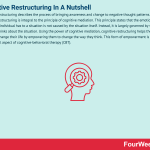What is Cognitive Restructuring? Cognitive Restructuring In A Nutshell

Cognitive restructuring describes the process of bringing awareness and change to negative thought patterns. Cognitive restructuring is integral to the principle of cognitive mediation. This principle states that the emotional reaction an individual has to a situation is not caused by the situation itself. Instead, it is largely governed by what the individual thinks about the situation. Using the power of cognitive mediation, cognitive restructuring helps the individual change their life by empowering them to change the way they think. This form of empowerment is a fundamental aspect of cognitive-behavioral therapy (CBT).
Understanding cognitive restructuringWhen an individual experiences trauma, certain thought patterns establish themselves and create a distorted view of reality. These negative thought patterns are called cognitive distortions, which over time lead to anxiety and depression.
Cognitive distortions are habitual ways of interacting with the world. They cause the individual to react negatively to certain people or stimuli – irrespective of whether the perceived threat is real or imagined.
Common cognitive distortions that need to be restructuredThere is of course no limit to the extent of scenarios that could elicit a negative response.
However, most people respond to such a situation by using common cognitive distortions including:
Black and white thinking – or a failure of judgement in thinking that fails to assess both the positive and negative aspects of self or others.Catastrophizing – where the individual tends to assume the worst will happen. It can also involve an exaggeration of the magnitude of a negative situation.Rumination – or a focus on repeatedly and obsessively thinking the same thoughts in a negative loop. There is a fixation on the causes and consequences of distress to the detriment of any solution.Personalization – a harmful distortion where someone believes that things that have nothing to do with them are their fault. Cognitive restructuring techniquesCognitive restructuring techniques provide a means of analyzing and then rebuilding negative thought patterns into something more beneficial.
Here is how this technique should play out.
Self-awareness practiceCognitive restructuring cannot occur without some degree of self-awareness. Indeed, negative thought patterns must first be observed before they can be remedied.
When these thoughts do arise, write them down in a journal. Where and when do they occur? Are there commonalities or trends? Record and observe self-analysis without judgment.
Question assumptionsMany negative thought patterns can be traced back to assumptions or generalizations.
When an individual catches themselves making an assumption, they should begin a process of self-inquiry:
Are my thoughts based on emotion or fact?Is there evidence that challenges my assumption?Is the situation black and white? Or are there shades of grey?In theory, this self-inquiry should unearth flaws in assumptive thinking.
Gather evidenceWhat is causing the negative thought pattern to be triggered? The individual should record any early memories they deem a potential culprit.
Create different thoughtsWith an understanding of the drivers of negative thought patterns, the individual can use evidence to guide future responses.
This starts by incorporating evidence-based thinking into their responses when triggered. Here, the focus is on small wins. Many will discover that replacing negative thought patterns is a slow and arduous process requiring patience.
Be self-compassionateThose who tend to be self-critical will suffer the most when their negative thought patterns make a comeback out of nowhere.
The individual must remember that no-one is perfect and have self-compassion for the difficult journey they have embarked on.
Key takeaways:Cognitive restructuring is an evidence-based approach to eliminating negative thought patterns.Cognitive restructuring is effective in treating cognitive distortions, or negative and habitual ways of interacting with the world. Self-awareness is key to successful cognitive restructuring. Without an ability to identify and observe negative thought patterns, the individual will be unable to incorporate more beneficial ways of thinking.Main Free Guides:
Business ModelsBusiness StrategyBusiness DevelopmentDigital Business ModelsDistribution ChannelsMarketing StrategyPlatform Business ModelsTech Business ModelThe post What is Cognitive Restructuring? Cognitive Restructuring In A Nutshell appeared first on FourWeekMBA.



